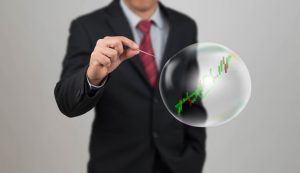Market Bubbles: It’s Not the Price, It’s the Mentality
The comments below are an edited and abridged synopsis of an article by Lance Roberts
The S&P 500 is currently trading nearly 90% above its long-term median, which is expensive from a historical perspective. However, since stock market bubbles are a reflection of speculation, greed and emotional biases, valuations are only a reflection of those emotions. In other words, bubbles can exist even when valuations and fundamentals might argue otherwise.

Market crashes are an emotionally driven imbalance in supply and demand.
In a market crash, the number of people wanting to sell vastly overwhelms the number of people willing to buy. It is at these moments that prices drop precipitously, as sellers drop the levels at which they are willing to dump their shares in a desperate attempt to find a buyer. This has nothing to do with fundamentals. It is strictly an emotional panic, which is ultimately reflected by a sharp devaluation in market fundamentals.
Comparing the current market to any previous period in the market is pointless. The current market is not like 1995, 1999, or 2007. Valuations, economics, drivers, etc. are all different from one cycle to the next. Most importantly, however, the financial markets adapt to the cause of the previous fatal crashes, but that adaptation won’t prevent the next one.
Currently, there is a strong belief that the financial markets are not in a bubble, and the arguments supporting that belief are based on comparisons to past market bubbles.
In a world where there is virtually no fear of a market correction, and a sense of urgency to be invested, and continuous bullish chatter, it is likely that the markets are poised for the unexpected, unanticipated and inevitable event.
‘This time’ is only different from the standpoint that the variables are not exactly the same as they were previously. The variables never are, but the outcome is always the same.
